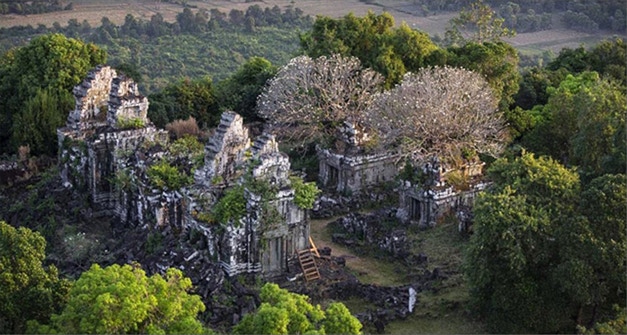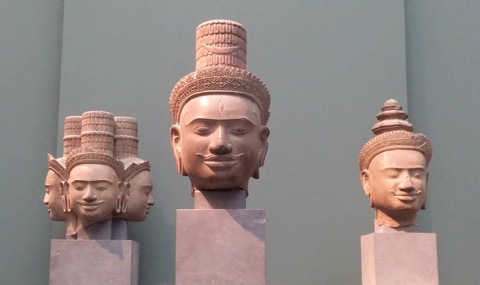PHNOM
BOK
(889-915)

PHNOM
BOK
(889-915)

AERIAL VIEW, PHNOM BOK (889-915)
This aerial view (taken from Google Images) offers a more comprehensive perspective than any photograph taken at the site (and precludes the need to climb its 221m height.) It also provides an alternative to a site plan which, in any case, would be identical to that of Phnom Krom and hypothetical, at that, with the same three prasats, four possible crematoria, two of which have sprouted arboreal shikharas, the service buildings and enclosure walls only evidenced by rubble around the temple precinct. In the distance are fields where rice continues to be grown.

THE TRIMURTI, PHNOM BOK, MUSÉE GUIMET (889-915)
Thes three heads above representing the Hindu Trimurti or Trinity were found at Phnom Bok, where they were probably not an ensemble, as here, but possibly the cult images in each of its three shrines. Brahma, the Creator, is at left, identifiable by his four heads facing the cardinal directions of the world he created (his fifth on top was severed by Shiva in a fit of pique.) Shiva, the Destroyer, or less pejoratively, the Transformer, has been placed at the center and is identified by his third eye and the crescent moon, symbolizing change, while here his hair is braided not disheveled, styled much like Brahma's. At right, Vishnu, the Preserver, wears a crown symbolizing his role in maintaining order on Earth, ensuring divine writ or dharma is enforced, the proper function of kingship, as understood in feudal Hindu societies. His crown is octagonal, like the middle section representing him in a tripartite, aniconic linga; (Brahma the base is square.) The miter also replicates the tiers of a prasat’s shikhara, symbol of Mt. Meru, bastion of the gods, Earth's ultimate rulers, posthumous home of its kings and location of these statues.
No attempt has been made to individualize or characterize these gods' features or even make them identifiably Southeast Asian; they exude a common god-like serenity, radiating self-sufficiency, if not self-satisfaction. The cyclical interrelationship of these three deities in Hindu cosmology meant there was no need to give one primacy; a worshiper was free to pick whichever he or she felt the greatest bhakti or devotion towards. Thus, Hinduism avoided Christianity's Trinitarian contortions and controversies since its three gods were fundamentally interchangeable as manifestations of the absolute, Brahman.
The remarkable state of preservation of these busts and the fact they have not been dispersed to different museums around the world results from their having been deliberately hidden at the bottom of a well near the site where the French archaeologists of the EFEO discovered them. They appear to have been placed there not long after the temple's construction, presumably to protect them from some invading army of Thai Buddhists from Ayutthaya or Hindu Chams with their capital at Indrapura near today's Danang in Vietnam, perhaps even Cambodia's own Theravada Buddhists. It may seem surprising that co-religionists were not reluctant to sack temples to their own deities, until one recalls that these shrines were built not from piety but to persuade the fickle gods to support their sponsors. Since the trio of busts had eluded looters for so many centuries, the Cambodians did not know of their existence and their place of origins was in ruins, the French apparently felt entitled to take them back to Paris, where they are centerpieces of the exceptional Khmer collection of the Musée Guimet.
45